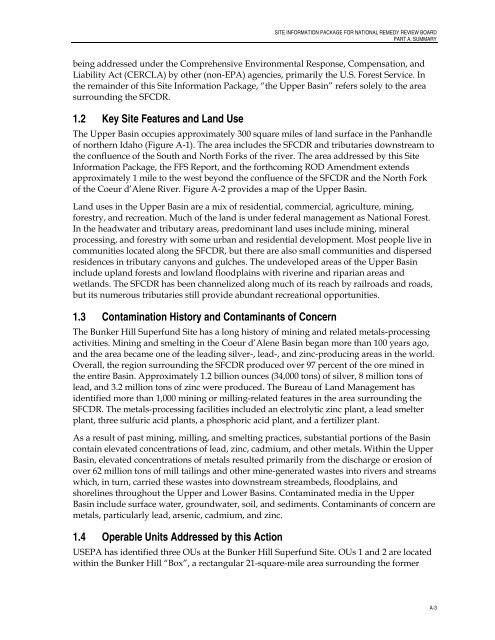Final Site Information Package for National Remedy Review Board ...
Final Site Information Package for National Remedy Review Board ...
Final Site Information Package for National Remedy Review Board ...
You also want an ePaper? Increase the reach of your titles
YUMPU automatically turns print PDFs into web optimized ePapers that Google loves.
SITE INFORMATION PACKAGE FOR NATIONAL REMEDY REVIEW BOARD<br />
PART A, SUMMARY<br />
being addressed under the Comprehensive Environmental Response, Compensation, and<br />
Liability Act (CERCLA) by other (non-EPA) agencies, primarily the U.S. Forest Service. In<br />
the remainder of this <strong>Site</strong> <strong>In<strong>for</strong>mation</strong> <strong>Package</strong>, “the Upper Basin” refers solely to the area<br />
surrounding the SFCDR.<br />
1.2 Key <strong>Site</strong> Features and Land Use<br />
The Upper Basin occupies approximately 300 square miles of land surface in the Panhandle<br />
of northern Idaho (Figure A-1). The area includes the SFCDR and tributaries downstream to<br />
the confluence of the South and North Forks of the river. The area addressed by this <strong>Site</strong><br />
<strong>In<strong>for</strong>mation</strong> <strong>Package</strong>, the FFS Report, and the <strong>for</strong>thcoming ROD Amendment extends<br />
approximately 1 mile to the west beyond the confluence of the SFCDR and the North Fork<br />
of the Coeur d’Alene River. Figure A-2 provides a map of the Upper Basin.<br />
Land uses in the Upper Basin are a mix of residential, commercial, agriculture, mining,<br />
<strong>for</strong>estry, and recreation. Much of the land is under federal management as <strong>National</strong> Forest.<br />
In the headwater and tributary areas, predominant land uses include mining, mineral<br />
processing, and <strong>for</strong>estry with some urban and residential development. Most people live in<br />
communities located along the SFCDR, but there are also small communities and dispersed<br />
residences in tributary canyons and gulches. The undeveloped areas of the Upper Basin<br />
include upland <strong>for</strong>ests and lowland floodplains with riverine and riparian areas and<br />
wetlands. The SFCDR has been channelized along much of its reach by railroads and roads,<br />
but its numerous tributaries still provide abundant recreational opportunities.<br />
1.3 Contamination History and Contaminants of Concern<br />
The Bunker Hill Superfund <strong>Site</strong> has a long history of mining and related metals-processing<br />
activities. Mining and smelting in the Coeur d’Alene Basin began more than 100 years ago,<br />
and the area became one of the leading silver-, lead-, and zinc-producing areas in the world.<br />
Overall, the region surrounding the SFCDR produced over 97 percent of the ore mined in<br />
the entire Basin. Approximately 1.2 billion ounces (34,000 tons) of silver, 8 million tons of<br />
lead, and 3.2 million tons of zinc were produced. The Bureau of Land Management has<br />
identified more than 1,000 mining or milling-related features in the area surrounding the<br />
SFCDR. The metals-processing facilities included an electrolytic zinc plant, a lead smelter<br />
plant, three sulfuric acid plants, a phosphoric acid plant, and a fertilizer plant.<br />
As a result of past mining, milling, and smelting practices, substantial portions of the Basin<br />
contain elevated concentrations of lead, zinc, cadmium, and other metals. Within the Upper<br />
Basin, elevated concentrations of metals resulted primarily from the discharge or erosion of<br />
over 62 million tons of mill tailings and other mine-generated wastes into rivers and streams<br />
which, in turn, carried these wastes into downstream streambeds, floodplains, and<br />
shorelines throughout the Upper and Lower Basins. Contaminated media in the Upper<br />
Basin include surface water, groundwater, soil, and sediments. Contaminants of concern are<br />
metals, particularly lead, arsenic, cadmium, and zinc.<br />
1.4 Operable Units Addressed by this Action<br />
USEPA has identified three OUs at the Bunker Hill Superfund <strong>Site</strong>. OUs 1 and 2 are located<br />
within the Bunker Hill “Box”, a rectangular 21-square-mile area surrounding the <strong>for</strong>mer<br />
A-3

















